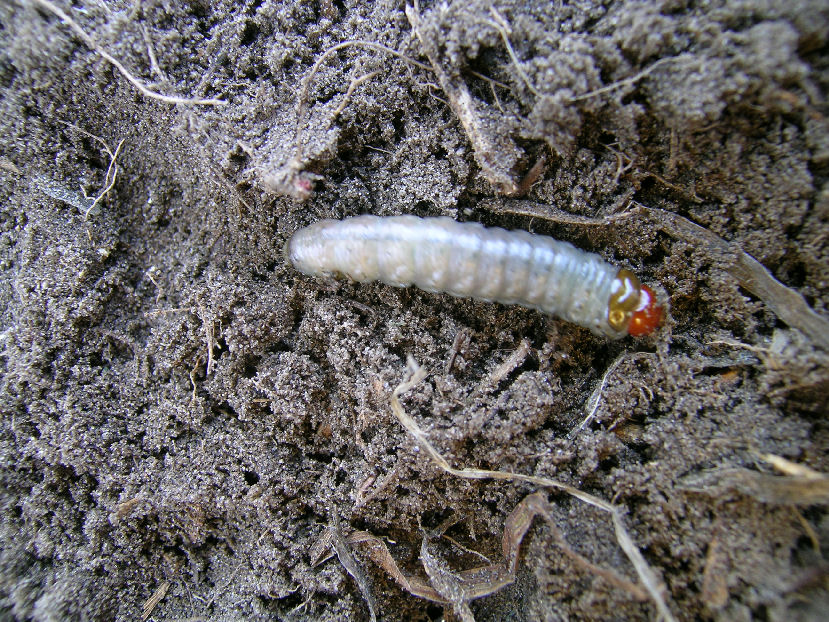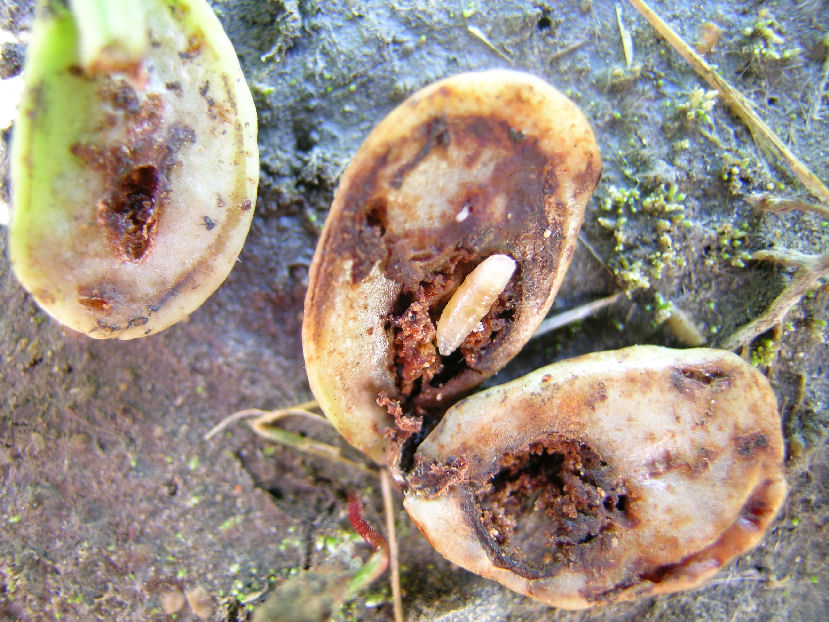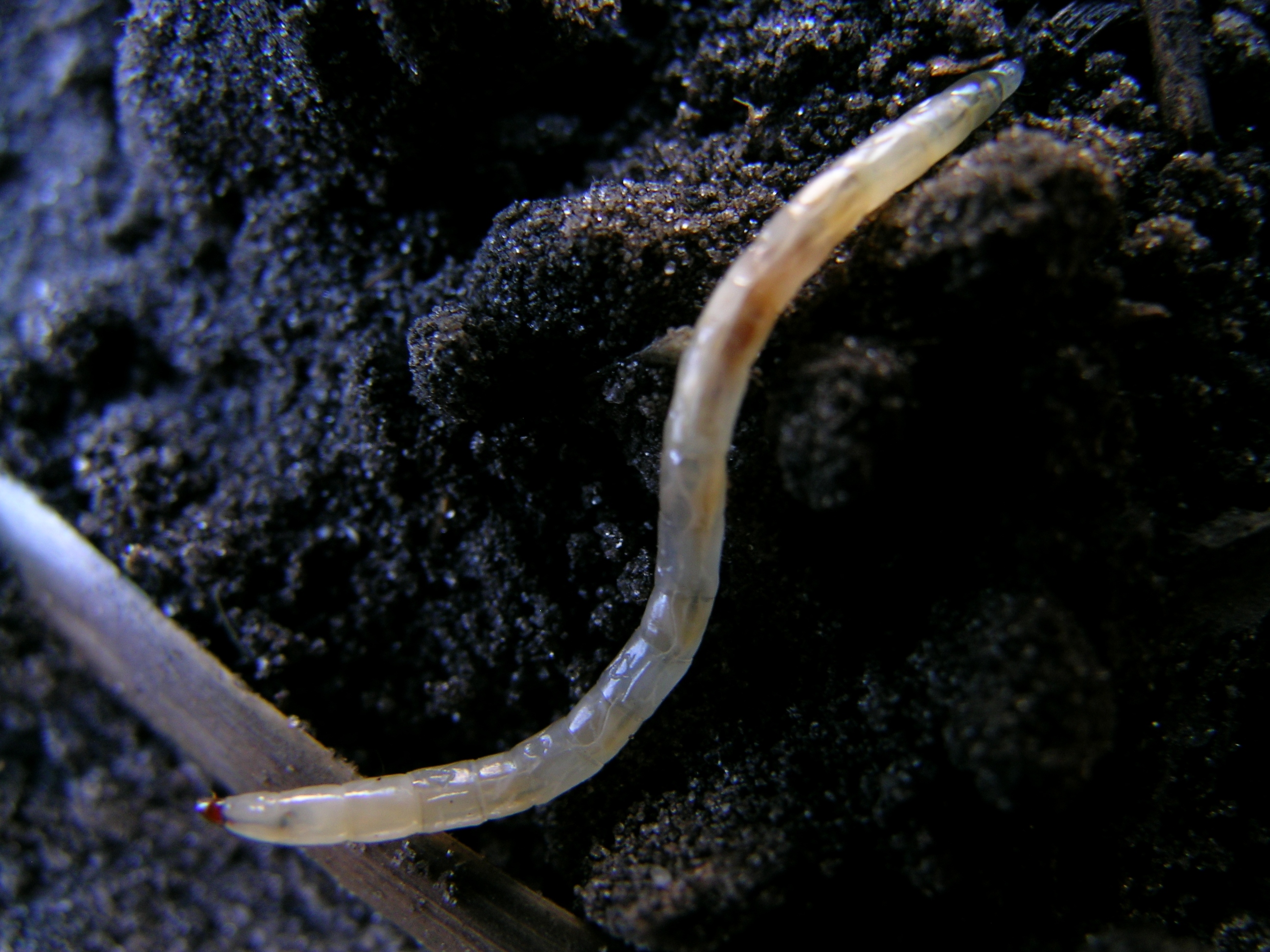Wireworms on Crops in the Canadian Prairies
Main species of wireworms
Other species of wireworms may be of greater concern to crops in other areas of Canada. In addition to differences in biology, there may be considerable differences in susceptibility to some insecticides between different species of wireworms.
How wireworms can damage crops
Larvae of wireworms feed underground on seeds, roots and other below-ground plant parts. They are attracted to germinating seeds by the CO2 given off during germination/respiration. They may shred the emerging tissue when it is still underground. The central leaves may emerge with feeding damage. In heavy infestations, bare patches may appear in the field and reseeding may be necessary. In most crops, wireworms do most of their damage in early spring, when they are near the soil surface. Wireworms can also burrow into potato seed pieces in the spring and into developing tubers in the fall.
Biology
 Figure 1. Wireworms
Figure 1. Wireworms |
Wireworms are slender, have hard bodies, and have 3 pairs of legs behind the head. The last abdominal segment is flattened with a keyhole-shaped notch. Size of fully-grown larvae varies between species. Larvae of the prairie grain wireworm are the larger of the 2 main species in the Canadian prairie provinces, and can reach a length of about 20 mm. How long larvae spend in the soil before pupating also varies between species of wireworms. The prairie grain wireworm normally remains in the larval stage for 3 to 4 years.
|
|---|
Host Crops
Scouting Techniques
Baits buried at marked locations in the spring or late summer can indicate where wireworms are present. Several types of baited have been studied for monitoring wireworm populations, including presoaked corn/wheat mixtures, oats, and potatoes. Baits are buried 7.5 to 15 cm deep in the soil, and checked for wireworms 7 to 10 days later. Competition from an abundant food supply in the soil around where the baits are buried can greatly reduce the number of wireworms recovered.
Soil may also be sieved through a screen to look for wireworms.
Economic Thresholds
Economic thresholds for wireworms are not known.
Control Tips
Seeding into warm and moist soil: Seeding into soil that is warm and moist may help promote quick germination. Quick germination and early growth of crops may reduce damage from wireworms. Shallow seeding may also speed up the early growth of plants if moisture is present.
Plant less susceptible crops in fields known to have a lot of wireworms: Research on wireworms in the genus Agriotes concluded that some plants such as flax, mustard and clover may be attacked less, partly because they are small and are sown shallow, and that buckwheat may also be less susceptible to damage by these wireworms. The same may be true for our main prairie species of wireworms.
Seed Treatments: Some seed treatments containing the neonicotinoid insecticides thiamethoxam, imidacloprid or clothianidin may protect the plants from wireworm damage, likely through prolonged wireworm intoxication, but populations of wireworm may not be significantly reduced. Seed treatments containing these insecticides should be used only as needed to manage wireworms or other insects that are known to be at populations of risk to the crop. Overuse when not needed can potentially lead to resistance, and seed treatments containing neonicotinoid insecticides have been shown to be capable of increasing spider mite levels in dry years in soybeans. So decisions need to be made considering the pests of potentially greatest concern.
Natural Enemies: Some ground beetles and rove beetles will feed on wireworms. Larvae of stiletto flies (Therevidae) are also predators of wireworms. Note that larvae of stiletto flies can look somewhat like wireworms (Fig. 4), but do not have legs. Some species of nematodes will also feed on wireworms.
The fungus Metarhizium anisopliae can infect and kill wireworms. A granular formulation containing this fungus is being tested to determine its potential as a microbial insecticide for wireworms.
Insects similar to Wireworms that may be found in the Soil


Figure 2. Glassy cutworm (Apamea devastator) Figure 3. Seedcorn maggot (Delia platura)


Figure 4. Therevid larva Figure 5. Crane fly larva

Figure 6. Centipede (top), wireworm (bottom)
